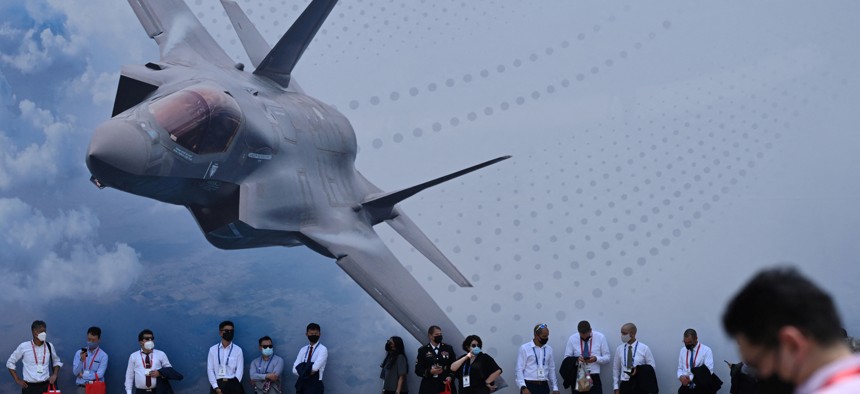
Visitors stand in the shade next to a display for Lockheed Martin as they watch the aerobatic display during the Singapore Airshow in Singapore on February 15, 2022. ROSLAN RAHMAN/AFP via Getty Images
Work Urgently, Lockheed’s New Space Chief Tells His Team
Robert Lightfoot wants to meet the Pentagon’s desire to move quickly.
With the Pentagon demand for new satellites and spacecraft growing by the day, the new head of Lockheed Martin’s $12 billion space business said he wants his 21,000-person team to hustle.
“We've got to establish a sense of urgency around all this,” said Robert Lightfoot, who in January was named executive vice president of Lockheed Martin’s space business unit.
Lightfoot, who concluded his long NASA career as its acting administrator from 2017 to 2018, takes the reins as Pentagon satellite spending is expected to increase. The United States is looking for more secure and redundant satellite constellations as Chinese and Russian anti-satellite arsenals improve.
He discussed his goals with three reporters in Washington this week.
“You've got to have that sense of urgency where everyday matters,” Lightfoot said. “I tell the team, we're competing with time.”
In recent years, the Pentagon has been pressing companies to move faster as the United States competes, and in some cases, plays catch-up to China’s weapons advances. The push has led traditional defense companies like Lockheed to adopt new technologies and to work with commercial firms and even start-ups.
“We have to put the transformation activities in place that allow us to go faster,” Lightfoot said.
He summed up his goals for the business in three words: protect, connect, and explore.
“Those are…a very simple concept for the team in terms of wrapping their head around what we're doing,” he said.
Like many defense executives, Lightfoot touted his company’s use of digital tools to design satellites and spacecraft. But he also talked about proving out technology before selling it. He mentioned Lockheed’s LM 400, a new satellite bus being marketed as a “highly configurable” to carry different payloads.
“We're gonna launch it,” Lightfoot said of the company-funded satellite bus. “We're gonna put our LM 400 tech demo on there and prove it out so that when we offer it for sale, we can actually say it's flown.”
Lockheed has poured $350 million into a new satellite factory south of Denver. In a first for the company, workers laid out its assembly line using a digital model of the factory.
“That allowed us to actually configure the entire space we're going to build those satellites,” Lightfoot said.
The technology will allow the company to build satellites faster, and shrink the manufacturing learning curve, he said.
Lightfoot said the company is putting 5G receivers on drones to test technology it wants to one day install on satellites.
Like most American companies, Lockheed is working harder to find workers. With more vacant jobs than unemployed Americans and the intense draw of the commercial-tech industry, Lightfoot has focused on selling the mission of the spacecraft his company builds.
“I'm not just hiring a mechanical engineer,” he said. “I'm hiring somebody to help me take astronauts to the moon and back home.”
Lightfoot said the company is trying to think differently about recruiting. At one recent event, he said, the company parked a van outside a taco joint with a television screen playing a video about space projects. He said the company hired 37 new employees at the event.
"What we find is in our world, our business, especially in space, that connectivity to the mission is really, really important,” Lightfoot said.
Among the work that really excites Lightfoot and his colleagues is the company building a new lunar rover with partner General Motors. The rover is expected to land on the moon in 2025, drive around robotically, and ultimately let astronauts take the wheel.
“The concept is to have a common chassis. Think of it almost like Lego blocks...that you can put mission packages on...whether it seats in a steering wheel for astronauts or different sensors,” said Lisa Callahan, vice president and general manager of commercial civil space.
“We're leveraging GMs expertise in driving common chassis across their fleet,” Callahan said. “We're also leveraging a ton of investment that they've made in their battery technology for their electric vehicles.”
Those batteries are expected to keep the rover powered throughout the cold, 14-day lunar night, Callahan said. Solar panels will recharge the batteries during daylight. Lockheed has put GM’s batteries in a thermal chamber and vacuum chambers to make sure they can operate in space temperatures.
It’s rare for a purely defense firm like Lockheed to work with a consumer firm like General Motors. Lightfoot said the partnership has given the engineers from both companies an opportunity to learn from one another.
“I think that the technical teams are having a lot of fun,” he said.




